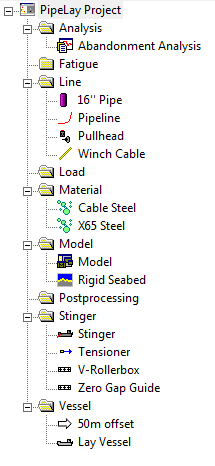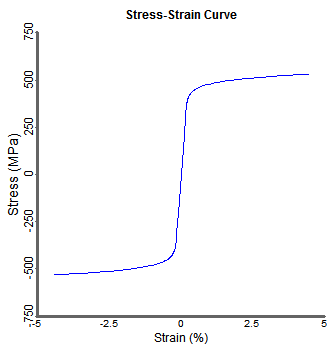The project sidebar for this example is shown in the figure below. The project sidebar shows all of the components that are used in the example. Each of these components is described in detail in the following sections.

Project Sidebar for Example 4
When a new PipeLay project is created it contains just a Project component. This component is used to store general project information such as the project title, location, and so on. The Project component is also used to specify certain project-specific settings such as the system of units to be used, global constants, finite element mesh settings and quality control procedures. For this example, the following information is stored in the general Project Settings dialog.
Table: General Project Settings
Property |
Value |
Project Title |
Example 4 - Recovery |
Job Number |
1-2-3-342 |
Engineer(s) |
Wood PLC |
Location |
Galway |
For this example, the default Metric unit system and the default Constants dialog values are used. Also, the ‘Quality Control’ section is left as per default.
The Material component is used to define the physical properties associated with a particular material. This example contains two Material components, which define the material properties for both non-linear X65 steel for the pipe section, as listed in the first table below, and linear steel for the cable, as listed in the second table below. The Material components are located in the Material folder and are named ‘X65 Steel’ and ‘Cable Steel’ respectively in this example.
Table: Material Properties for ‘X65 Steel’
Property |
Value |
Young's Modulus |
207 GPa |
Shear Modulus |
80 GPa |
Poisson’s Ratio |
0.3 |
Mass Density |
7850.0 kg/m3 |
Yield Strength |
450 MPa |
Allowable Stress |
100 % |
Allowable Strain |
0.25 % |
Expected Tension |
250 kN |
Non-linear Axial Stiffness |
No |
Use Criteria Tension |
No |

Stress-Strain Curve for ‘X65 Steel’
Table: Material Properties for ‘Cable Steel’
Property |
Value |
Young's Modulus |
207 GPa |
Shear Modulus |
79.9 GPa |
Poisson’s Ratio |
0.33 |
Mass Density |
7798.3 kg/m3 |
Coefficient of Expansion |
0 1/c |
Yield Strength |
448 MPa |
Allowable Stress |
100 % |
Allowable Strain |
0.25 % |
The Pipe Section component is used to specify the properties of an individual section of pipeline that has uniform properties. This example contains one Pipe Section component as follows:
▪The Pipe Section component is created in the Line folder and is named ‘16’’ Pipe’.
▪The specification is Standard.
▪The material used is ‘X65 Steel’, as defined previously.
▪The geometrical and hydrodynamic properties are listed in the table below.
Table: Properties for ‘16’’ Pipe’
Property |
Value |
Outer Diameter |
406.4 mm |
Thickness |
20 mm |
Normal Drag |
1 |
Normal Inertia |
2 |
The Cable component is used to specify the properties of an individual section of cable that has uniform properties. It is similar to the Pipe Section component in many respects, though less complex, as no additional coatings or attachments may be specified. This example contains one Cable component as follows:
▪The Cable component is created in the Line folder and is named ‘Winch Cable’.
▪The Standard specification is selected and the material used is ‘Cable Steel’, as defined previously.
▪A relatively low bending stiffness of 0.01 kNm² is explicitly defined.
▪The geometrical and hydrodynamic properties are listed in the table below.
Table: Properties for ‘Winch Cable’
Property |
Value |
Diameter |
100 mm |
Normal Drag |
1 |
Normal Inertia |
2 |
The Ancillary component is a general purpose component, which may be used to model a variety of appurtenances, such as pullheads, flanges, collars and so on. In this example, the ‘Winch Cable’ is connected to the pipeline by means of an Ancillary component. The Ancillary component is created in the Line folder and is named ‘Pullhead’. The component is created with the properties of Weight in Air of 20 kN and Weight in Water of 15 kN.
At this stage, enough components have been defined to allow for the specification of the pipeline stack-up, which is defined in a Line component named ‘Pipeline’. A summary of the pipeline stack-up is provided in the table below.
Table: Pipeline Stack-Up
Section |
Length |
Winch Cable(1) |
700 m |
Pullhead(1) |
- |
16’’ Pipe(1) |
750 m |
This example contains two Support components to model the supports on both the vessel and the stinger. Both Support components are created in the Stinger folder. One component is a Double V Support, named ‘V-Rollerbox’, and the other component is a Zero Gap O Support, named ‘Zero Gap Guide’. The ‘Zero Gap Guide’ component has a support length of 2 m. The properties of the ‘V-Rollerbox’ component are listed in the table below.
Table: Properties of ‘V-Rollerbox’
Property |
Value |
Support Length |
1 m |
Roller Length, L1 |
0 m |
Roller Length, L2 |
1 m |
Roller Length, L3 |
1 m |
Roller Angle, Theta 1 |
30 deg |
Roller Angle, Theta 2 |
90 deg |
Contact Stiffness |
5000 kN/m |
A single Tensioner component is created in the Stinger folder and is named ‘Tensioner’. ‘Zero-Gap Guide’ is used as the Tensioner Support.
A Stinger component is created to model the S-Lay stinger. This component is created in the Stinger folder and is named ‘Stinger’. Radius of Curvature Defined is selected as the stinger definition option. The Support Locations on the stinger are listed in the table below.
Table: Support Locations on ‘Stinger’
Support Name |
Support Location (m) |
V-Rollerbox |
0.0 |
V-Rollerbox |
12.2 |
V-Rollerbox |
24.4 |
V-Rollerbox |
36.6 |
V-Rollerbox |
48.8 |
V-Rollerbox |
61 |
V-Rollerbox |
73.2 |
V-Rollerbox |
85.4 |
V-Rollerbox |
97.6 |
V-Rollerbox |
109.8 |
The Support Locations correspond to the curvilinear distance along the arc from the top of the stinger, which is defined as being directly below the Centre of Curvature. The Centre of Curvature for the stinger is defined in the table below.
Table: Centre of Curvature for ‘Stinger’
Property |
Value |
Centre of Curvature – X |
-100 m |
Centre of Curvature – Y |
0 m |
Radius of Curvature |
100 m |
A Vessel component named ‘Lay Vessel’ is created in the Vessel folder. This component is used to model the lay vessel. The Standard Vessel Profile option is selected from the Profile Options drop-down list. The overall dimensions of the vessel are listed in the table below.
Table: Properties of ‘Lay Vessel’
Property |
Value |
Length |
220 m |
Depth of Keel below Origin |
15 m |
Horizontal Offset from Origin |
0 m |
Create Solid Profile |
No |
The Stinger Location and Support Locations are also defined in the Vessel component, the properties of which are listed in the two tables below respectively.
Table: ‘Stinger’ Location
Property |
Value |
X Coordinate |
4.8 m |
Y Coordinate |
-93.1 m |
Z Coordinate |
0 m |
Stinger Angle |
180 degrees |
Table: Support Locations on ‘Lay Vessel’
Support Name |
X Coordinate (m) |
Y Coordinate (m) |
Z Coordinate (m) |
Tensioner |
4.8 |
28.8 |
0 |
V-Rollerbox |
4. 7686 |
16.6 |
0 |
V-Rollerbox |
4. 7686 |
4.4 |
0 |
V-Rollerbox |
4. 7686 |
-7.8 |
0 |
V-Rollerbox |
4. 7686 |
-20.0 |
0 |
V-Rollerbox |
4. 7686 |
-32.2 |
0 |
V-Rollerbox |
4. 7686 |
-44.4 |
0 |
V-Rollerbox |
4. 7686 |
-56.6 |
0 |
V-Rollerbox |
4.7686 |
-68.8 |
0 |
V-Rollerbox |
4. 7686 |
-81.0 |
0 |
The Vessel Offset component is used to specify the static offset that is to be applied to a vessel in an analysis. This example contains one Vessel Offset component named ‘-50m Offset’, which defines a surge offset of -50m.
A single Seabed component is created in the Model folder and is named ‘Rigid Seabed’. The default properties of a rigid seabed, with a zero coefficient of friction in the longitudinal and transverse directions and a slope of zero degrees, are left unchanged.